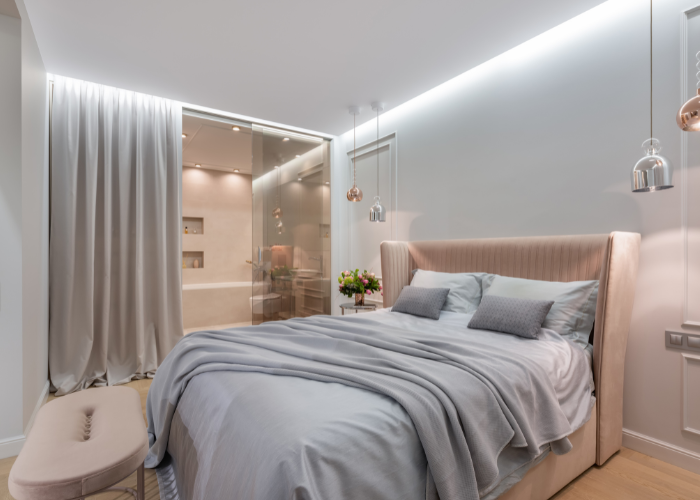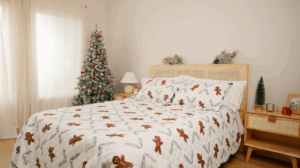
How to Create a Minimalist Bedroom Retreat Without Sacrificing Comfort
In today’s fast-paced world, your bedroom should be a place to sleep and your sanctuary. But if your space is cluttered, overstimulating, or chaotic, it may be doing the opposite of helping you rest. The minimalist bedroom trend offers a refreshing shift toward simplicity, calm, and function. Still, there’s a common concern: Will a minimalist space feel too bare or sterile?
The good news is that you don’t have to choose between a sleek, clean space and one that feels soft, cozy, and inviting. You can create a minimalist bedroom retreat that nurtures your well-being, without sacrificing comfort. Here’s how to do it right.
1. Start With a Clear Vision
Minimalism isn’t about deprivation; it’s about intention. Begin by asking yourself what you want to feel when you walk into your bedroom. Calm? Restored? Unburdened? Use that feeling as your guide. Decluttering is an essential first step. Go through your furniture, décor, and personal items, and pare back anything that doesn’t support your vision. Keep only what’s useful, beautiful, or brings you a sense of peace.
2. Prioritize Soft, Neutral Colors
A minimalist bedroom doesn’t have to be stark white. Too much white can feel cold. Instead, opt for soft, neutral palettes, think warm greys, sandy beiges, muted greens, or calming blues. These tones soothe the mind and create visual simplicity, which helps the brain relax.
Paint your walls in these hues, and carry the theme through your bedding, curtains, and rugs. Keeping a consistent color scheme not only looks clean but also reduces visual noise.
3. Choose Quality Over Quantity
Instead of filling your room with lots of furniture or decorative accents, focus on a few high-quality pieces that add value and comfort.
A well-made bed, a streamlined nightstand, and perhaps one comfortable chair are often all you need. Invest in a mattress that supports your sleep health, and select pieces that are built to last. Natural materials like wood, linen, and cotton are ideal for both aesthetics and comfort.
4. Embrace the Power of Textures
Minimalist doesn’t mean flat. Introducing different textures helps prevent your space from feeling cold or empty.
Layering soft materials, like a chunky knit throw, a linen duvet, or a plush area rug, adds warmth and dimension without clutter. One of the best ways to do this is with high-quality bedding that offers both simplicity and tactile comfort. For example, percale bedding is an excellent choice if you want that crisp, breathable, hotel-like feel that complements a minimalist aesthetic. It’s smooth, cool to the touch, and gets softer with every wash, making it a favorite for both comfort and style.
5. Let in Natural Light
One of the hallmarks of a restful space is access to natural light. If possible, keep window treatments simple and light, sheer curtains or adjustable blinds that allow for both privacy and sunlight. Exposure to natural light during the day can also help regulate your circadian rhythm, improving sleep quality. At night, keep the lighting soft and warm. Use dimmable lamps or sconces to create a cozy ambiance, and consider swapping harsh blue light for bulbs with a warmer color temperature.
6. Minimize Visual Clutter
Even if your room is technically “clean,” visual clutter can make it feel chaotic. That’s why storage solutions are key in a minimalist bedroom. Use baskets, under-bed bins, or built-in drawers to hide away items you don’t use daily. Keep surfaces like your nightstand or dresser nearly bare, with only one or two carefully chosen items, perhaps a small plant, a carafe of water, or a favorite book.
When everything has a place, it becomes much easier to maintain a sense of calm and order.
7. Add Greenery, Mindfully
A little life goes a long way in a minimalist space. Houseplants not only purify the air but also contribute to a sense of peace and connection to nature. Choose low-maintenance plants like snake plants, pothos, or peace lilies. Limit yourself to one or two in the bedroom, and place them strategically, on a windowsill, a corner stool, or a floating shelf, to enhance the space without overwhelming it.
8. Incorporate Scent and Sound
Minimalism also extends to your senses. Creating a retreat means engaging more than just your eyes. Essential oils, candles, or diffusers can subtly add soothing scents like lavender, chamomile, or sandalwood. White noise machines or soft music playlists can help set the tone for rest, especially if you live in a noisy environment. The goal is to design a space that feels serene in every sense.
9. Make Your Bed a Priority
In a minimalist bedroom, the bed is the focal point, and arguably the most important investment in your comfort. Keep bedding simple but indulgent. A streamlined duvet, two or four quality pillows, and breathable sheets are all you need. Avoid over-accessorizing with decorative pillows or throws unless they serve a functional purpose. Clean lines and thoughtful materials are the name of the game.
The right bedding not only elevates your space but also directly contributes to better sleep, which impacts your mood, immune function, and overall well-being.
10. Maintain the Ritual
Minimalism is not a one-time project. It’s a mindset. Regularly check in with your space. Are things starting to pile up again? Are you holding onto items that no longer serve you? A five-minute nightly reset, folding blankets, putting away clothes, and clearing your nightstand can help maintain the tranquil environment you’ve created. And over time, these small rituals reinforce the sense of peace and order your bedroom is meant to provide.
Final Thoughts
A minimalist bedroom retreat isn’t about having less. It’s about having what truly matters. By combining clean design with cozy textures, natural elements, and high-quality essentials, you can create a space that supports good sleep, and a healthier, calmer life.
Simplicity and comfort aren’t opposites. When you design with care and intention, they go hand in hand.



